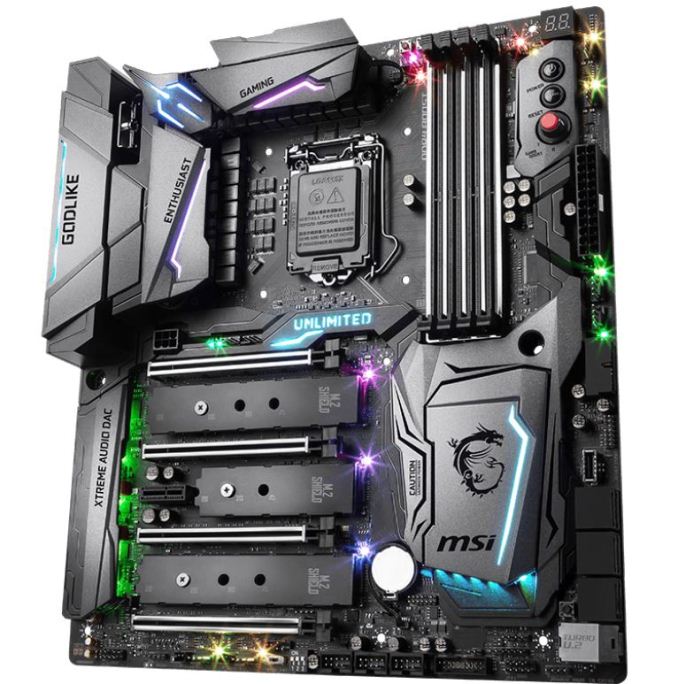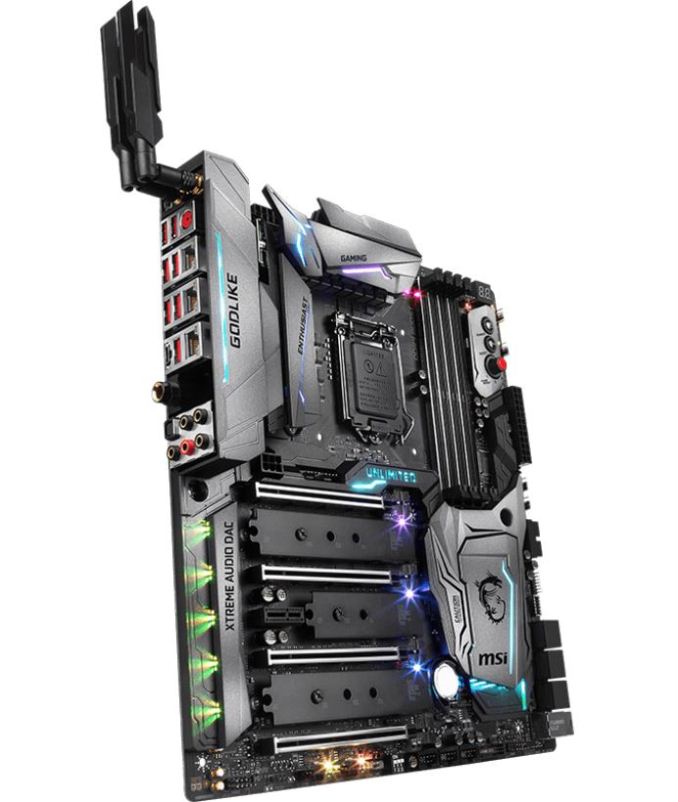Analyzing Z370 for Intel's 8th Generation Coffee Lake: A Quick Look at 50+ Motherboards
by Ian Cutress, Anton Shilov, Joe Shields & Gavin Bonshor on October 20, 2017 2:00 PM ESTOur next board partner in the roundup is MSI. MSI brings ten Z370 motherboards to the table, from the entry-level Z370-A Pro to the flagship Z370 Godlike Gaming. We have divided these up by MSI's existing product stack delineation. We'll start with the Enthusiast Gaming line, then cover Performance Gaming, Arsenal Gaming, and Pro lineups.
MSI Z370 Godlike Gaming
The Godlike Gaming is an E-ATX sized board which comes with a lot of features. One of the first features that stuck out in my mind is a triple Killer E2500 LANs + Killer Wi-Fi, along with U.2 support and support for five M.2 based devices when using the included PCIe riser card. It also comes with a beefy power delivery and a Game Boost knob for easy overclocking. Can we still turn it up to 11? (Ian: yes, it goes up to 11)
The Z370 Godlike Gaming’s appearance is an all-black PCB with dark gray shrouding all over the board. Not only is the back panel IO and audio section covered, so is the right side of the board starting from the chipset heatsink on all the way up to the onboard power, reset, and game boost overclocking buttons. RGB LEDs find their way under these shrouds as well as under the PCH heatsink and miscellaneous places around the board. There are additional headers on the board for adding more RGB, all of which are controlled my MSI’s Mystic Light App. The VRM heatsinks are large hunks aluminum but appear to not be connected to each other. All the full-length PCIe and memory slots are reinforced, as well as the three onboard M.2 slots which are using MSI’s M.2 Shield to help cool the drives.
Memory slot support is the platform standard here as well with four slots supporting up to 64GB, up to a supported speed of DDR4-4133, which is one above the other boards in the product stack which max out at DDR4-4000. All the memory slots are steel reinforced and use a one-sided locking mechanism. The board has a total of four full-length reinforced PCIe slots and one x1 slot, which combined can handle 2-way SLI and up to 4-Way AMD Crossfire. This means that the CPU uses an x8/x4/x4 layout from the processor, using slots 1, 2, and 4, while the bottom full-length slot is from the chipset. Slots 1 and 4 are used in a dual GPU configuration allowing for adequate spacing between the cards for better cooling, so the options become x16/0/0 for single cards, x8/0/x8 for dual cards, and x8/x4/x4 for triple cards.
The storage options on this board are plentiful in number and type. On the board are three PCIe 3.0 x4 M.2 slots, all using MSI's M.2 Shield. There is also a possibility to add two more M.2 drives through an add-in card, which is bundled with the board in certain regions. SATA support runs the same as the other boards at six and supports RAID 0, 1,5, and 10. A fairly unique addition is a single U.2 slot. The M.2 slots, U.2 port, and SATA ports are partly switched (using one might disable something else), so be sure to check the manual for the breakdown.
There are a total of 10 fan headers on the board scattered all around the board; all of which can be controlled via the BIOS or MSI Command Center. Audio functionality is handled by the Realtek ALC1220 codec and includes Nichicon and WIMA audio caps as well as an ESS E9018 DAC for driving headphones. The Z370 Godlike also has a debug LED, power and reset buttons, as well as the Gameboost overclocking knob.
MSI quadrupled down on the Rivet Networks Killer products and have three E2500 NICs on board as well as Killer 1535 Wireless LAN and Bluetooth (4.1) module. This is because the board can act like a networking switch through the updated Killer software: users can have the motherboard act as a passthrough for other devices set up nearby, such as a console or a NAS. In order to enable this feature, Killer required the motherboard to have at least three of its network controllers. If the main internet access is acquired through one of the ethernet ports, the motherboard can use the Wi-Fi module as a local access point to the network, enabling wireless devices around the system. The only drawback to this feature is that the PC needs to be on and awake at all times.
There are three USB3.1 (10 Gbps) ports handled by the ASM3142 controller with one Type-A and one Type-C on the back panel and another Type-C port available through the internal connector. We also see two native USB 3.1 (5Gbps) ports on the rear panel and four controlled by the ASM1074 hub. The rest are available through internal USB connectors. The back panel IO contains the Killer Wi-Fi module, a CMOS reset button, combination PS/2 port, the three Killer NICs, a plug audio stack with SPDIF and a 6.3mm headphone jack. Because the back panel does not have video outputs, a discrete GPU is a requirement for this motherboard.
| MSI Z370 Godlike Gaming | |
| Warranty Period | 3 Years |
| Product Page | Link |
| Price | Amazon US |
| Size | E-ATX |
| CPU Interface | LGA1151 |
| Chipset | Intel Z370 Express |
| Memory Slots (DDR4) | Four DDR4 Supporting 64GB Dual Channel Support DDR4 4133+ |
| Network Connectivity | 3 x Rivet Networks Killer E2500 LAN 1 x Killer 1535 Wi-Fi w/Bluetooth (4.1) |
| Onboard Audio | Realtek ALC1220 |
| PCIe Slots for Graphics (from CPU) | 3 x PCIe 3.0 x16 slots @ x16, x8/0/x8, x8/x4/x4 |
| PCIe Slots for Other (from Chipset) | 1 x PCIe 3.0 x16 slots @ x4 1 x PCIe 3.0 x1 slots @ x1 |
| Onboard SATA | 6 x Supporting RAID 0/1/5/10 |
| Onboard SATA Express | None |
| Onboard M.2 | 3 x PCIe 3.0 x4 - NVMe or SATA |
| Onboard U.2 | 1 x PCIe 3.0 x4 |
| USB 3.1 (10 Gbps) | 1 x Rear Panel Type-C (ASMedia) 1 x Rear Panel Type-A (ASMedia) 1 x Onboard Header |
| USB 3.1 (5 Gbps) | 2 x Rear Panel (Native) 4 x Rear Panel (ASMedia Hub) 2 x Onboard Headers |
| USB 2.0 | 3 x Headers |
| Power Connectors | 1 x 24-pin EATX 1 x 8-pin ATX 12V 1 x 4-pin ATX 12V 1 x 6-pin PCIe |
| Fan Headers | 1 x 4-pin CPU 1 x 4-pin Waterpump 8 x 4-pin System Fan |
| IO Panel | 1 x Clear CMOS button 2 x Wi-Fi Antenna connectors 1 x PS.2 keyboard/mouse port 6 x USB 3.1 (5 GBps) Type-A ports 3 x LAN (RJ45) ports 1 x USB 3.1 Type-C 1 x USB 3.1 Type-A 1 x 6.3mm stereo headphone jack 1 x Optical S/PDIF out 5 x Audio Jacks |













83 Comments
View All Comments
weevilone - Wednesday, October 25, 2017 - link
Notable that though the new boards are often very similar to their Z270 predecessors, Asus has dropped Thunderbolt 3 support from the Maximus X Hero board.masouth - Thursday, October 26, 2017 - link
ASUS ROG Z370 Maximus X Hero"....new metallic heat sinks that are an upgrade over the plastic heatsinks found on the Z270 version"
Please excuse my ignorance because I didn't own a ROG Z270 mb but...plastic HEAT SINKS? Not shrouds or decoration over a heat sink but the actual heat sinks themselves? That's either wrong, they performed their job pretty poorly, or plastic resins have advanced a lot farther in thermal conductivity (and cost for such) than I realized.
flowrush - Sunday, November 19, 2017 - link
"The other main distinguishable feature is the inclusion of integrated 802.11ac Wi-Fi with an antenna (that can only be described as a shark fin) found on the F."The above is incorrect in the article. The integrated Wi-Fi module with antenna is found on the E not the F.
Coldgame - Saturday, November 25, 2017 - link
I'm looking to build a rig with the Z370 Gaming ITX/ac, a GTX-1070 card and an Apple Thunderbolt Display.The review states:
"The key difference in the support between the two boards is going to be the Thunderbolt 3 port on the Gaming-ITX. This port supports video outputs..."
So, can anyone confirm or deny that video generated by the GTX-1070 can be output through the onboard Thunderbolt 3 port?
hanselltc - Sunday, December 3, 2017 - link
Looking forward to low-middle end mITX choices from this platform. It'll probably be paired with a 8100/8300 and be my secondary machine.Roen - Sunday, February 4, 2018 - link
Where are the 10 Gbps ports on the back? They all look like 5 Gbps ports, even the Type C.rbarak - Wednesday, February 21, 2018 - link
Is anyone using the Z370-P on Linux with two screens?I built a new machine based on the Z370-P, and both the DVI and the HDMI connected screens show the same image, and the RHEL7 setup/displays show only one Unknown Display.
I follwed the advice on stackexchange, and added this line:
$ grep GRUB_CMDLINE_LINE_DEFAULT /etc/default/grub
GRUB_CMDLINE_LINE_DEFAULT="i915.alpha_support=1"
Then I did:
sudo grub2-mkconfig -o "$(readlink /etc/grub2.conf)"
And rebooted, but still, the two displays are not shown.
dromoxen - Wednesday, May 9, 2018 - link
Shocked to see that both the Asrock mitx boards are "szie=ATX" .. LOLThe addition of Tunderbolt sure seems to add a hefty premium £120 vs £160 , luckily I can do without.
Kroebo - Sunday, October 7, 2018 - link
Sadly, I discovered that the ZUG Gaming PLUS doesn't support SLI.trag - Tuesday, January 15, 2019 - link
On the ASrock Z370M Pro4 the M.2 slot information is backwards. Both slots support NVME. One slot also supports SATA. As written, "The first M.2 slot is SATA only while the second supports PCIe." it seems to say that one slot is SATA only and the other slot is PCIe (NVME) only.